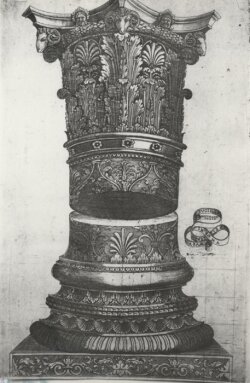Make it classy! How the Renaissance codified a style
Repeat after me: Doric, Ionic, Corinthian, Tuscan, and Composite— anyone who’s taken high school Latin knows these are the five types of columns used in Roman architecture. Right? Wrong! As the University of Virginia Art Museum’s current exhibition, “Variety, Archeology, and Ornament: Renaissance Architectural Prints from Column to Cornice,” shows, Roman builders were much more imaginative than later architectural experts, like Palladio and Vignola, would have us believe.
Looking at etchings and engravings of columns may not sound like an exciting way to spend a Saturday afternoon, but the story revealed by the drawings, prints, and books displayed is surprisingly lively (especially when narrated by Museum director Bruce Boucher). Curated around a collection of 16th century architectural engravings attributed to Master G.A with the Coltrop— a moniker worthy of a hip-hop artist— the exhibit shows how printing technology enabled the spread of architectural knowledge and influenced the interpretation of antiquities.
The problem for European builders prior to the 16th century was that the most famous work on classical architecture, Vitruvius’ 10-volume De Architectura, was not only difficult to understand but also contained no illustrations. Yet physical evidence was plentiful. In the 15th century, Leon Battista Alberti’s own illustrated architectural treatise began categorizing some of this extant evidence, and he advised students to learn about architecture onsite by drawing ancient buildings and ruins. Another suggestion: avoid introducing perspective, which distorts measurement, and instead draw using right angles—a method that evolved into the modern-day blueprint.
With the advent of printing, such drawings became widely available, thus saving architects a trip to Italy. Also, translators began publishing editions of Vitruvius with illustrations inserted. (Palladio himself even provided the drawings for one such volume.) The loose-leaf prints, which often became separated from their original context, recorded the inventive range of ornamentation found in ancient architecture— beautiful details that got tossed aside when Serlio, Vignola, and Palladio established their unified and codified guides to classical architectural style.
“Variety, Archeology, and Ornament” traces the evolution of this streamlining while also showing the eye-opening diversity of ornament that actually existed— such as a column capital carved to resemble a basket with fruit spilling over the top. One of the most interesting items displayed is a 16th-17th century German album— essentially an architectural enthusiast’s scrapbook— filled with cut-up prints. The show also features an iPad app (unfortunately, unavailable for purchase).
Beautifully curated, the exhibit dusts off little-known details in the history of classical architecture.
The exhibition, “Variety, Archeology, and Ornament: Renaissance Architectural Prints from Column to Cornice,” is on view through December 18 at the University of Virginia Art Museum. 155 Rugby Road. 924-3592.
